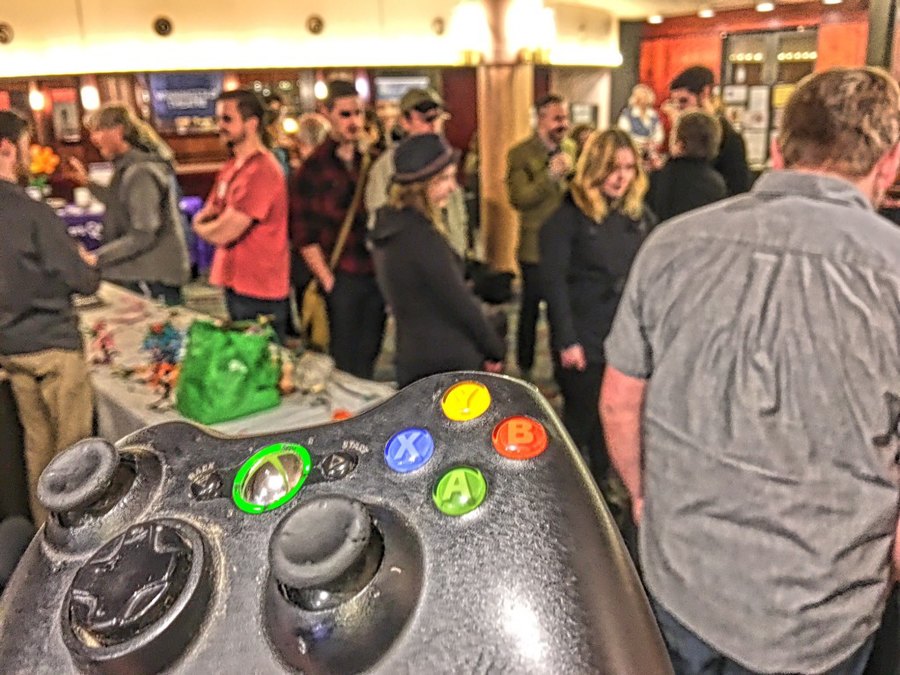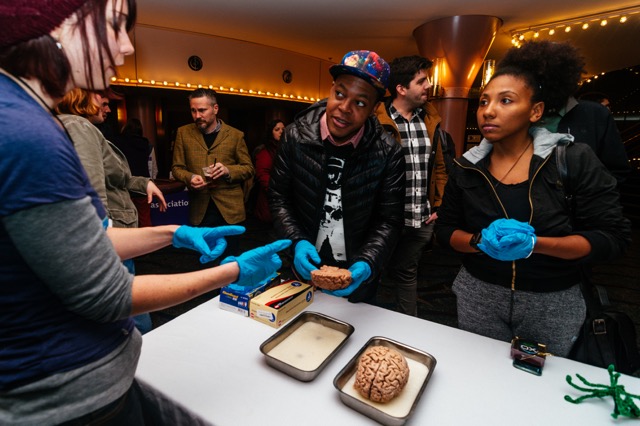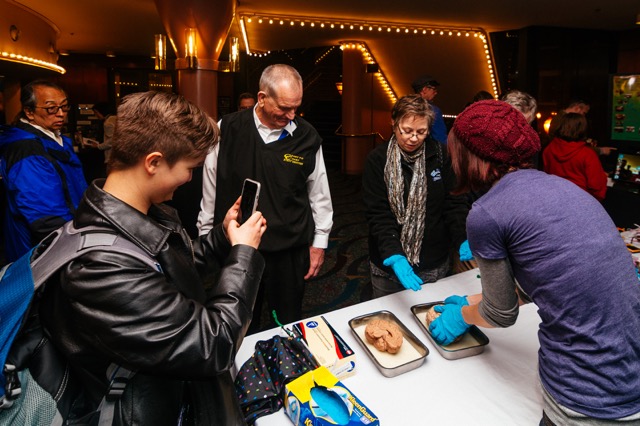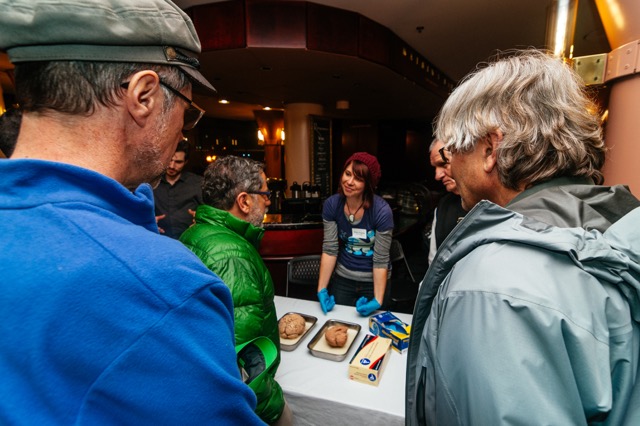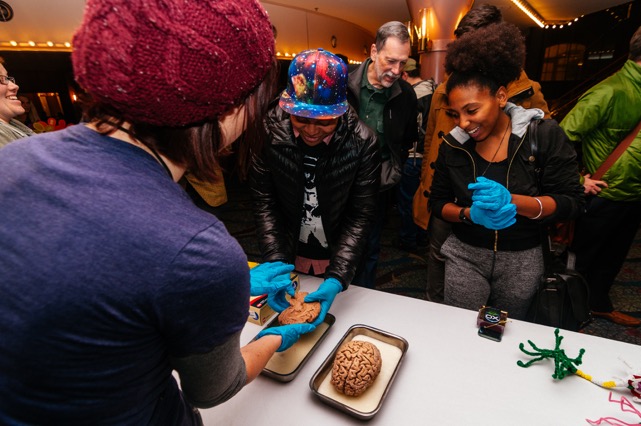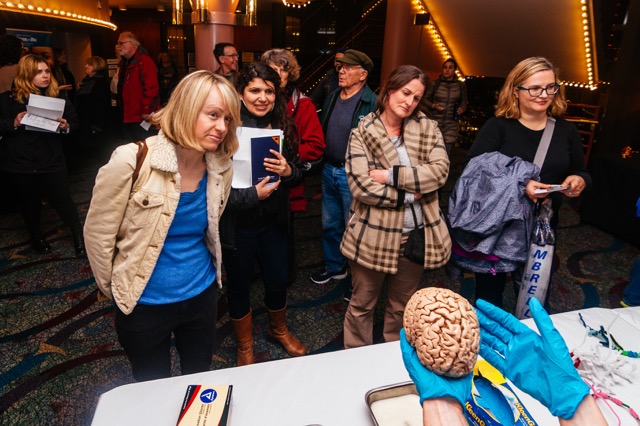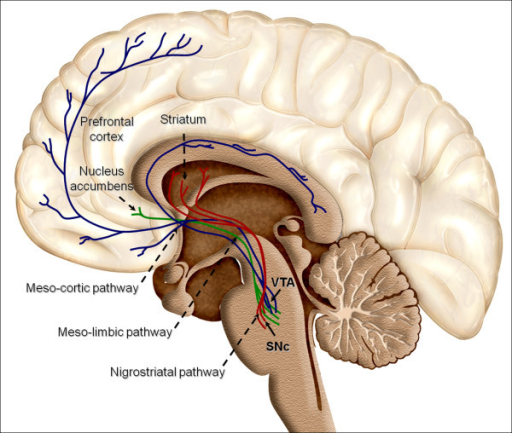Thanks to Kate Stout of the OHSU Brain Institute, NW Noggin had plenty of space on Monday night, for brains, games, and our eager volunteers from Portland State University, and WSUV…
We were there to learn about how video games might improve cognitive performance, from Adam Gazzaley, a professor of Neurology, Physiology and Psychiatry, and Director of the Neuroscience Imaging Center at the University of California San Francisco…
Our Noggin volunteers included Ben Yefimov, Angela Gonzalez, John Harkness and Kim Engeln from WSUV Neuroscience, and Alex Voigt and Austin Howard from Psychology at PSU, all excited to attend the second lecture of OHSU’s Brain Awareness season…
Brittany Wouden, a recent graduate of WSUV, brought along her sought after educational myBrain! app, which attracted visitors delighted to see an image of a brain superimposed on live video of their own head! They dramatically swung open hemispheres, and gamely explored which networks are active during various cognitive states…
The engaging power of technology to encourage people to consider the physical networks responsible for their own perceptual and cognitive experiences is hard to deny… 🙂
We also used our extensive table real estate (thank you Kate!) to build sizable pipe cleaner neural networks, and offer attendees the chance to examine and heft some real human brains…
Pic above by Alex Voigt
Our art projects are often low tech, and affordable, and quite often we’ve found them as compelling as digital technology, able to engage and challenge young minds in the exploration of complex concepts in science (real brains and enthusiastic volunteers certainly help tremendously too!)…
Pic above by Alex Voigt
Pic above by Alex Voigt
Pic above by Alex Voigt
Pic above by Alex Voigt
We then happily filed into the Newmark auditorium to hear Michael Gazzaley introduce his celebrated and promising research on “Gaming and the Brain…”
Dr. Gazzaley began by pointing out our evident human drive to excel in many physical areas, including strength, coordination, speed and endurance. Then he asked: What about efforts to optimize the core abilities of the human brain, including perception, attention, information processing, cognitive control, and other key aspects of cognition..?
This is a particularly important question in two major areas, he suggested: education, and medicine. We have a “low understanding” of what’s going on in kids’ brains in classrooms, he added, along with notably “poor assessments” to determine what kids need in terms of brain training in order to succeed…
There are treatments to improve cognitive function, he acknowledged, but most involve drugs. And drugs are crude tools, argued Dr. Gazzaley, especially since we know very little about brain development, or about the natural variability in brain structure and function. And right now, in both doctor’s offices and schools, we don’t tailor treatments to individuals, and we don’t always try more than one approach to address mental health concerns like ADD, or depression…
Dr. Gazzaley proposes to radically alter this approach, and wants to develop video game-based brain training tools and assessments to offer “targeted, personalized, multimodal, closed loop” interventions. He imagines games that record player responses, and in real time update the requirements, applying personalized changes. He asks: “Can we take new technology, leverage off of innovative new development, and improve our cognition?”
So why video games? Video games, claims Dr. Gazzaley, can create powerful experiences, which are the key to brain plasticity!
When you are playing a first person shooter game, for example, the experience is “completely immersive – like watching a major motion picture but where you’re a character” (and also one in danger of being shot!)…
Dr. Gazzaley cited research suggesting that young people who play these games have “superior abilities” in terms of reaction time, cognitive control, task switching, and decision making. He ultimately wants to use video games as “digital medicine” to create experiences that enhance cognition in those at every age…
Dr. Gazzaley is particularly well-known for a study documenting improvements in cognitive control in older adults, after they trained with a video game he helped develop, known as “Neuroracer…”
In the game, you drive a car along a road, but you also have to react to various signs along the way, responding when a particular stimulus (say a green circle) appears on the sign, but not responding when any other stimulus appears. The game also adjusts its complexity and challenge in real time to help players advance their skills…
Neuroracer requires multi-tasking, and significant cognitive control, as you have to simultaneously excel in both spatial navigation (driving) and perceptual discrimination. It is difficult, even for people in their twenties. However, Dr. Gazzaley’s older subjects were excited to play, and practice, and improve – when it comes to video games, he explained, “everyone wants to level up!”
In the graph above, the red 0% line means perfect performance on both tasks – again, even young adults can’t reach this level, and there is further decline with every decade of life. This decline is mirrored by EEG measures of cognitive control; specifically electrical fluctuations detected over the medial frontal lobes (midline frontal theta waves) that peak at the most challenging part of the game, when those road signs requiring discrimination appear.
Frontal theta as a mechanism for cognitive control (2014)
Midline frontal theta is an electrical signal indicating the engagement of prefrontal cortical brain areas required to effectively respond to demanding cognitive challenges, and these waves decline in amplitude, and get delayed as we get older, and less behaviorally adept at the game…
But Dr. Gazzaley found that practice with the Neuroracer game dramatically improved both performance and EEG measures of prefrontal cortical function in older adults. In fact, after one month of training, both performance and theta waves were at levels higher than those of young adults! And these improvements persisted long after the study, with no additional training…
Dr. Gazzaley also mentioned research indicating that these improvements in the game transferred to improvements in other cognitive measures of attention, and memory…
His success in the field earned him, and his collaborators, the cover of Nature magazine, which Dr. Gazzaley likened to making the cover of “Rolling Stone” for musicians… 🙂
You can read the entire Nature article here, or download the pdf at the link below…
Nature_2013-Video-game-training-enhances-cognitive-control-in-older-adults
Dr. Gazzaley and his collaborators have since gone on to create new games (including Meditrain, and Rhythmicity, the latter the result of a partnership with Grateful Dead drummer Mickey Hart) designed to target specific neural concerns, and they have embarked on multiple research projects to investigate the utility and effectiveness of these potentially new digital medicines to treat a variety of serious brain disorders…
His lab has also pioneered efforts to acquire detailed EEG data, in real time, from subjects playing these games, using an alluring technology known as Glass Brain…
He suggests that by 2020, medical interventions for, say, an attentional disorder, might be much more personal, targeted, and multimodal, and perhaps involve fewer drugs, more accurate assessments – and video games!
Yet Dr. Gazzaley also imagines all of us drawn to these brain enhancing games, using the latest digital technology, including virtual reality devices, to enjoy a kind of neuro crossfit training – to enhance our perceptual and cognitive abilities with the help of engaging games…
It sounds exciting, and the goal of replacing blunt, indiscriminate drug therapy alone with more targeted, personalized behavioral interventions is laudable and terrific.
And it made us think. Video games are changing, some suggest for the better, “becoming increasingly complex, diverse, realistic, and social in nature.” But what about costs? Would digital medicines be cheaper than pills, or would the technological infrastructure required be a barrier to access? What about kids already saturated with smartphones, and perhaps even dependent on video games?
EXPLORE MORE: Computer and video game addiction-a comparison between game users and non-game users
EXPLORE MORE: Attention-Control Video Game Curbs Combat Vets’ PTSD Symptoms
Dopamine pathways in the brain
And as a parent lucky enough to take my own rambunctious kids and their friends on hikes through the extraordinary landscapes of the Northwest, where they were clearly immersed, tested with real time feedback as they clambered up hills, over rocks, and past waterfalls, often genuinely exhilarated by outdoor experience, and perhaps even sporting larger hippocampi and less likely to exhibit symptoms of ADHD as a result, I wonder about strapping on virtual reality goggles to achieve similar effects…
Noggin volunteers have also led many classrooms in creative, perhaps brain-enhancing work, with students immersed in the experience of building their own clay cerebrums, paper lobes, and pipe cleaner cells… 🙂
Many thanks to Kate Stout at the OHSU Brain Institute for inviting us to another thought-provoking night at the Newmark Theater…



